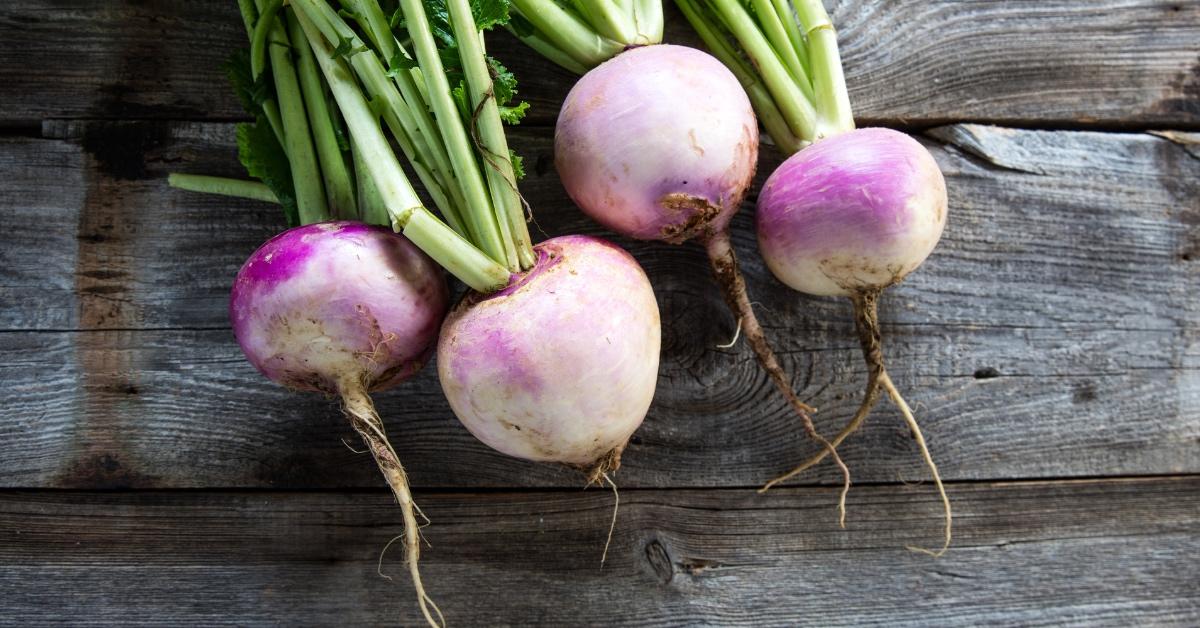Have you ever wondered what turnips taste like?
Well, get ready to embark on a delightful culinary journey through the world of turnips.
From their diverse flavors to their versatility in the kitchen, turnips are a hidden gem just waiting to be discovered.
So, join us as we unravel the mysteries behind these intriguing root vegetables, and prepare to have your taste buds tantalized like never before.
Get ready to fall in love with the humble turnip!
what do turnips taste like
Turnips have a range of flavors depending on their variety and preparation.
Raw turnips have a spicy, peppery taste and a firm, crunchy texture.
Young turnips taste sweeter, similar to carrots, while older turnips can be spicier and sometimes bitter.
When cooked, turnips become soft and creamy, with flavors ranging from sweet, peppery, and nutty to earthy and savory.
Roasted turnips taste like a cross between a potato and a carrot, with added sweetness from caramelization.
Pickled turnips have a salty, peppery, vinegary, and tangy taste.
Overall, turnips can be described as having a mix of flavors, including spicy, peppery, earthy, nutty, savory, and sweet.
Key Points:
- Turnips have a range of flavors depending on their variety and preparation.
- Raw turnips have a spicy, peppery taste and a firm, crunchy texture.
- Young turnips taste sweeter, similar to carrots, while older turnips can be spicier and sometimes bitter.
- Cooked turnips become soft and creamy, with flavors ranging from sweet, peppery, and nutty to earthy and savory.
- Roasted turnips taste like a cross between a potato and a carrot, with added sweetness from caramelization.
- Pickled turnips have a salty, peppery, vinegary, and tangy taste.
what do turnips taste like – Watch Video


Pro Tips:
1. Turnips are part of the cruciferous vegetable family, which also includes broccoli, cauliflower, and cabbage.
2. Some people describe the taste of turnips as a combination of cabbage, radish, and potato, with a slightly sweet and peppery flavor.
3. Turnip greens, the leaves of the turnip plant, have a slightly bitter taste and are often used in Southern cuisine as a substitute for collard greens or spinach.
4. The taste of turnips can vary depending on the variety and age of the vegetable. Young turnips tend to have a milder and sweeter taste, while older turnips can be more pungent and bitter.
5. In addition to being consumed as a vegetable, turnips are also used to make alcoholic beverages, including a traditional Scandinavian drink called “snaps,” which is made by fermenting turnips with spices and herbs.
Baby Bunch Turnips: Sweet And Crisp Flavor
Baby Bunch Turnips are a delightful variety of turnips that are harvested early to retain their small size and bring out their sweet and crisp flavor. These turnips have a distinctive taste that is both sweet and slightly tangy. The texture of baby bunch turnips is crisp and crunchy, making them a favorite choice for fresh salads. You can enjoy them raw as a refreshing snack or incorporate them into a variety of dishes to add a touch of sweetness.
Hakurei Turnips: Light And Sweet, Perfect For Salads
Hakurei Turnips, a Japanese variety, are renowned for their light and sweet flavor. These small turnips, measuring about 3 inches in diameter, are ideal for salads due to their delicate taste. They possess a subtle earthy undertone that perfectly complements a range of fresh ingredients. In Japanese cuisine, Hakurei turnips are commonly consumed in their raw form or as part of a chilled dish. Their inherent sweetness adds a refreshing twist to salads or appetizers.
- Hakurei turnips are prized for their light and sweet flavor
- Small size (about 3 inches in diameter) makes them perfect for salads
- Delicate taste with a slight earthy undertone
- Complements a variety of fresh ingredients
- Often enjoyed raw or as a cold dish in Japanese cuisine
“Hakurei turnips bring a refreshing twist to salads and appetizers.”
Milan Turnips: Premium, Soft, And Buttery
Milan Turnips are considered premium turnips due to their short cultivation time and small size. These turnips have a unique texture that is soft and almost buttery. Their taste is sweet and subtly earthy, with a hint of nuttiness. Milan turnips make an excellent choice for roasting or adding to side dishes. The creamy and smooth consistency of these turnips adds a touch of luxury to any meal.
- Milan Turnips are considered premium turnips
- Short cultivation time and small size contribute to their premium status
- Unique texture – soft and almost buttery
- Sweet and subtly earthy taste with a hint of nuttiness
- Ideal for roasting and adding to side dishes
- Creamy and smooth consistency adds a touch of luxury to any meal.
Purple-Top White Globe Turnips: Peppery Flavor, Ideal For Stews
If you’re looking for a turnip variety with a distinct peppery taste, then Purple-Top White Globe Turnips are the way to go. These turnips are known as the “mammoth forage turnip” due to their larger size. They take about 55 days to mature and develop a spicy kick. Purple-Top White Globe Turnips are often added to stews to contribute their unique flavor profile. The peppery taste adds depth and complexity to any hearty dish.
Scarlet Queen Turnips: Vibrant Color For Salads
Scarlet Queen Turnips are a visually striking variety with reddish-purple skin. These turnips not only add a pop of color to your dishes but also offer a delightful taste. They have a milder flavor compared to some other varieties, making them perfect for salads.
- Unique Appearance: Scarlet Queen Turnips have a vibrant, reddish-purple skin that makes them visually appealing.
- Milder Flavor: Unlike other turnip varieties, Scarlet Queen Turnips have a milder taste, making them suitable for salads.
- 60 Days to Mature: These turnips take around 60 days to fully mature, allowing you to enjoy their crispness and flavor relatively quickly.
In summary, Scarlet Queen Turnips bring both visual appeal and a distinct flavor to your salads. With their reddish-purple skin and milder taste, they add a unique touch to any dish.
Shogoin Turnip: Versatile In Japanese Cuisine
Another Japanese variety, the Shogoin Turnip, is known for its versatility in Japanese cuisine. These turnips take longer to mature, around 70 days, but they are worth the wait. They can reach up to 20 inches in length, making them perfect for stir-fry salads or pickling. The Shogoin Turnip offers a balance of flavors with a hint of sweetness and a slight earthy taste. Its versatility makes it a prized ingredient in a variety of Japanese dishes.
White Egg Turnips: Crispy And Juicy, Ideal For Raw Consumption
Resembling the shape and size of a white egg, the White Egg Turnip offers a unique taste and texture. This turnip variety is best enjoyed raw due to its high water content, providing a crispy and juicy experience. When consuming White Egg Turnips raw, you’ll notice their firm and crunchy texture without any bitter aftertaste. They are also suitable for hearty stews when cooked, contributing a delightful texture and subtle flavor.
Turnip Taste: Raw Vs. Cooked, Spicy To Sweet
The taste of turnips can vary depending on whether they are raw or cooked.
- Raw turnips have smooth, crispy, and starchy skin.
- Young turnips, such as Baby Bunch Turnips, taste sweet, similar to carrots.
- On the other hand, older turnips can have a spicier and sometimes bitter taste.
However, when cooked, the taste and texture of turnips change significantly.
- They can become soft, creamy, buttery, or even velvety in texture.
- The taste of cooked turnips can range from spicy and peppery to earthy, nutty, savory, or even sweet.
- The bitterness of turnip greens, if present, can be reduced by pre-boiling them.
- Boiled turnips resemble boiled potatoes but with a stronger flavor profile, while cooked turnips have a delightful blend of sweetness, pepperiness, and nuttiness reminiscent of potatoes.
- Turnips can be enjoyed raw or cooked, offering a versatile taste experience.
- Young turnips are sweet, similar to carrots, while older turnips can be spicier.
- Cooked turnips have a range of flavors, from spicy and peppery to earthy and nutty.
- Pre-boiling turnip greens can help reduce any bitterness.
- Boiled turnips have a stronger flavor profile, while cooked turnips are sweet, peppery, and nutty like potatoes.
Cooking Techniques: Boiled, Roasted, And Pickled Turnips
Turnips can be prepared using various cooking techniques to enhance their flavors and textures. Boiling turnips is a popular method that is often utilized to soften their texture and bring out their natural taste. When boiled, turnips take on a texture similar to boiled potatoes but with a more pronounced flavor.
Roasting turnips is another fantastic way to enjoy their natural flavors. Roasting brings out the sweetness of turnips and adds a caramelized touch. Seasoning them with salt, pepper, rosemary, and olive oil can further enhance their taste.
Pickling turnips offers a tangy and flavorful experience. The pickling process infuses the turnips with a delightful combination of saltiness, pepperiness, vinegary notes, and tanginess. Pickled turnips are often enjoyed as a condiment or a snack on their own.
Recommended Pairings: Turnips In Soups, Stews, And Mashes
Turnips are versatile root vegetables that can enhance the flavor and texture of dishes in various ways.
In soups and stews, turnips serve as complementary ingredients, adding a unique touch to the overall flavor. They can be used as a substitute for potatoes, bringing a different taste and texture to the dish. Turnips in soups and stews contribute a pleasant earthiness with a hint of spice.
Another popular method of preparation is mashing turnips. When mashed, turnips offer a flavor profile similar to mashed sweet potatoes, making a delicious alternative to traditional mashed potatoes. Mixing mashed turnips with other root vegetables creates a harmonious blend of flavors.
Additionally, sliced raw turnips can be a great addition to salads. They provide a spiciness, peppery taste, crunch, and texture that complement the fresh ingredients.
The versatility of turnips allows you to experiment with different cooking techniques and pairings to find what works best for your taste preferences.
To summarize, turnips are versatile root vegetables with a range of flavors and textures. From the sweet and crisp baby bunch turnips to the peppery purple-top white globe turnips, there is a variety to suit every palate. Whether you enjoy them raw, boiled, roasted, or pickled, turnips offer a unique taste experience. They can be paired with a variety of ingredients in soups, stews, mashes, and salads to enhance the overall flavor of a dish. Turnips’ ability to adapt and blend well with other ingredients makes them a fantastic addition to any culinary repertoire. So go ahead, explore the world of turnips, and discover the wide array of flavors they have to offer.
- Turnips are complementary in soups and stews
- They can substitute for potatoes with a different taste and texture
- Mashed turnips are similar to mashed sweet potatoes
- Mixing mashed turnips with other root vegetables provides a harmonious blend of flavors
- Sliced raw turnips add spiciness, peppery taste, crunch, and texture to salads.

You may need to know these questions about what do turnips taste like
What does a cooked turnip taste like?
When cooked, a turnip transforms into a deliciously sweet, nutty, and earthy vegetable. Its texture also undergoes a remarkable change, turning soft and velvety, similar to its cold-weather counterpart, the parsnip. The previously crisp and starchy flesh of a raw turnip is replaced with a tender and deeply satisfying sensation. Whether roasted, boiled, or sautéed, a cooked turnip offers a delightful combination of flavors that are sure to please the palate.
What is the best way to eat turnips?
One delightful way to savor turnips is to roast them with a drizzle of olive oil and a sprinkle of herbs. This technique enhances their natural sweetness and adds a pleasant caramelized flavor. Another option could be incorporating thinly sliced turnips into a refreshing and crunchy coleslaw. Blending the crispiness of turnips with the creaminess of the coleslaw dressing creates a unique and delicious side dish that pairs well with various meals.
What does a turnip taste similar to?
Turnips have a unique flavor that is often described as a milder version of radishes. The taste is slightly peppery and refreshing. Unlike rutabagas, turnips are more tender, making them versatile for various cooking methods. They can be boiled, roasted, or even enjoyed raw in salads for a crisp and subtly tangy addition.
Do turnips taste similar to potatoes?
No, turnips do not taste similar to potatoes. While potatoes have a mild, starchy flavor, turnips have a more distinctive and slightly bitter taste. Some describe the flavor of turnips as a combination of a radish and a carrot. Therefore, these two root vegetables have different flavor profiles and cannot be considered similar in taste.
Reference source
https://americasrestaurant.com/turnips-taste/
https://www.masterclass.com/articles/learn-about-turnips
https://fruitsandveggies.org/stories/top-10-ways-to-enjoy-turnips/
https://www.quora.com/Is-a-turnip-similar-in-taste-and-texture-to-a-parsnip-I-am-looking-for-a-potato-substitute-and-the-turnip-has-a-very-strong-taste



